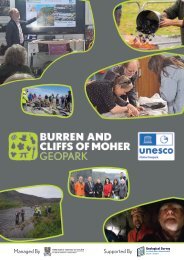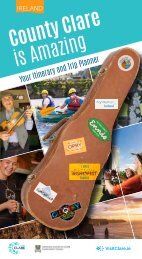Burren and Cliffs of Moher UNESCO Global Geopark - Geology
A collection of articles about the geology in the Burren and Cliffs of Moher UNESCO Global Geopark written by Dr Eamon Doyle - Geopark Geologist
A collection of articles about the geology in the Burren and Cliffs of Moher UNESCO Global Geopark written by Dr Eamon Doyle - Geopark Geologist
Create successful ePaper yourself
Turn your PDF publications into a flip-book with our unique Google optimized e-Paper software.
Fossil Wind<br />
Ancient ripples formed by wind waves on a<br />
shallow coast 315 million years ago.<br />
There are three main rock types; Igneous rocks<br />
which are formed from molten magma from the<br />
Earth’s interior that has cooled, Sedimentary rocks<br />
which are formed from particles (sediments); bits<br />
<strong>and</strong> pieces <strong>of</strong> rocks <strong>and</strong> fossils <strong>and</strong> Metamorphic<br />
rocks which are any rock that has been deformed<br />
by deep burial <strong>and</strong> the forces <strong>of</strong> plate tectonics.<br />
The rocks <strong>of</strong> the <strong>Burren</strong> are sedimentary rocks.<br />
At the <strong>Cliffs</strong> <strong>of</strong> <strong>Moher</strong>, the layers are made <strong>of</strong><br />
particles <strong>of</strong> s<strong>and</strong> <strong>and</strong> mud <strong>and</strong> occasionally bits <strong>of</strong><br />
fossils. These particles were transported by rivers<br />
from long-gone distant mountains <strong>and</strong> finally<br />
deposited into the sea. After they were buried by<br />
more <strong>and</strong> more sediment they were eventually<br />
turned into rock. So, while the s<strong>and</strong> <strong>and</strong> mud<br />
<strong>and</strong> bits <strong>of</strong> l<strong>and</strong> plants <strong>of</strong>ten ended up in the sea,<br />
they were transported considerable distances<br />
from where they were originally eroded on l<strong>and</strong>.<br />
As these bits <strong>of</strong> eroded l<strong>and</strong> entered the sea, they<br />
were sometimes buried beside sea creatures that<br />
were living in the sea at that time. So, we <strong>of</strong>ten find<br />
l<strong>and</strong> <strong>and</strong> sea creatures preserved together there.<br />
The limestone <strong>of</strong> the <strong>Burren</strong> is also a sedimentary<br />
rock, but limestone is a bit different. The particles<br />
that make up limestone are <strong>of</strong>ten dominated by<br />
fossils or fragments <strong>of</strong> fossils. They haven’t been<br />
transported by rivers <strong>and</strong> are usually turned<br />
into rock close to where they lived. All the<br />
fossils in the <strong>Burren</strong> limestone are sea creatures<br />
<strong>and</strong> lived <strong>and</strong> died in a shallow tropical sea.<br />
Here the process <strong>of</strong> turning into rock is quicker<br />
as the tropical seas are very rich in calcium<br />
carbonate which crystalizes out to form the<br />
cement that holds all the bits <strong>of</strong> fossils together.<br />
This can happen very shortly after the creatures<br />
died <strong>and</strong> they don’t need to be buried deeply.<br />
The processes that act on the particles <strong>of</strong> s<strong>and</strong>,<br />
mud or fossils while they are on the seafloor can<br />
tell us a lot about where exactly they were, <strong>and</strong><br />
this is one way we get to underst<strong>and</strong> what was<br />
happening over 300 million years ago. One <strong>of</strong><br />
those processes is wave action produced by wind.<br />
When wind blows across a body <strong>of</strong> water it can<br />
generate a circular motion in the water, these<br />
circular cells <strong>of</strong> water decrease in size the deeper<br />
you go in the water until at a certain depth they<br />
disappear. If the water is shallow enough, those<br />
circular cells will impact the sea floor creating a<br />
back-<strong>and</strong>-forth motion that can move the loose<br />
s<strong>and</strong> on the seafloor. This back-<strong>and</strong>-forth motion<br />
creates wave ripples. If these are buried by another<br />
layer <strong>of</strong> s<strong>and</strong>, they may be preserved as fossil<br />
ripples. They are, in effect, fossilized wind energy.<br />
These ripples, which can be seen along the<br />
walls <strong>of</strong> the path along the <strong>Cliffs</strong> <strong>of</strong> <strong>Moher</strong> have<br />
been quarried locally. We know how important<br />
waves are to local surfing <strong>and</strong> energy generation<br />
now, they have been important to whoever<br />
was living here for over 300 million years.<br />
Article written by Dr. Eamon Doyle, Geologist for<br />
<strong>Burren</strong> <strong>and</strong> <strong>Cliffs</strong> <strong>of</strong> <strong>Moher</strong> <strong>UNESCO</strong> <strong>Global</strong> <strong>Geopark</strong>, Clare County Council.<br />
www.burrengeopark.ie


















